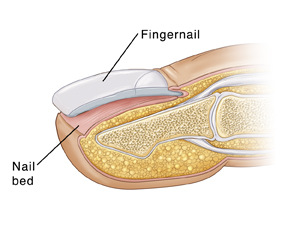Detached Fingernail or Toenail
A detached nail is when the nail becomes separated from the area underneath it (the nail bed). This often means losing all or part of the nail. An injury to your finger or toe is often the cause. It can also be caused by an infection or other skin diseases around or under the nail.
Sometimes there is a cut in the nail bed or a bone fracture under the nail. In most cases, the nail will grow back from the area under the cuticle (the matrix). A fingernail takes about 4 to 6 months to grow back. A toenail takes about 12 months to grow back. If the nail bed or matrix was damaged, the nail may grow back with a rough or abnormal shape. In some cases, the nail may not grow back at all.

There may be damage or a cut to the nail bed. This may need to be repaired. Often this is done with stitches. If the nail is still in good condition, it might be cleaned and trimmed, then put back in place. This is done to help protect the new nail as it grows back. It also prevents the nail bed from drying out.
Home care
-
Keep the injured hand or foot raised above the level of the heart to reduce pain and swelling. This is important, especially in the first 48 hours.
-
Apply an ice pack for up to 20 minutes. Do this every 3 to 6 hours during the first 24 to 48 hours. Keep using ice packs to ease pain and swelling as needed. To make an ice pack, put ice cubes in a plastic bag that seals at the top. Wrap the bag in a clean, thin towel or cloth. Never put ice or an ice pack directly on the skin. The ice pack can be put right on a wrap, cast, or splint. As the ice melts, be careful not to get any wrap, cast, or splint wet.
-
The nail bed is moist, soft, and sensitive. It needs to be protected from injury for the first 7 to 10 days until it dries out and becomes hard. Keep it covered with a nonstick dressing or a bandage with ointment.
-
When a dressing is placed on an exposed nail bed, it may stick and be hard to remove if left in place more than 24 hours. Unless you were told otherwise, change dressings every 24 hours. If needed, soak the dressing off while holding it under warm, running water. Then lightly pat the wound dry. Apply a layer of antibiotic ointment before putting on the new dressing or bandage. This will help keep it from sticking. Use a nonstick dressing over the ointment. Secure that with tape or gauze dressing.
-
If an X-ray showed that you have a fracture, it will take about 4 weeks for this to heal. The injured part should be protected with a splint or tape while it's healing.
Medicine
-
You can take over-the-counter medicine for pain, unless you were given a different pain medicine to use. Talk with your healthcare provider before using these medicines if you have medicine allergies or chronic liver or kidney disease. Also talk with your provider if you have a stomach ulcer or digestive bleeding, or if you're taking blood-thinner medicines.
-
If you were given antibiotics to treat or prevent infection, take them as directed until they are done. It's important to finish the antibiotics even if the wound looks better. This is to make sure the infection has cleared.
Follow-up care
Follow up with your healthcare provider, or as advised. If X-rays were taken, you'll be told of any new findings that may affect your care.
When to get medical advice
Call your healthcare provider right away if any of these occur:
-
Pain or swelling increases
-
Redness around the nail
-
Creamy white or yellow fluid (pus) draining from the nail
-
Fever of 100.4ºF (38ºC) or higher, or as advised by your provider
-
Uncontrolled bleeding
Online Medical Reviewer:
Jessica Gotwals BSN MPH
Online Medical Reviewer:
Michael Lehrer MD
Online Medical Reviewer:
Ronald Karlin MD
Date Last Reviewed:
3/1/2022
© 2000-2024 The StayWell Company, LLC. All rights reserved. This information is not intended as a substitute for professional medical care. Always follow your healthcare professional's instructions.